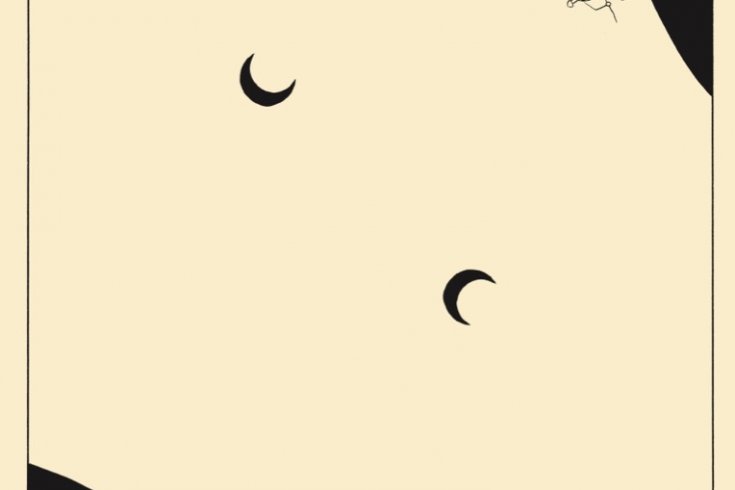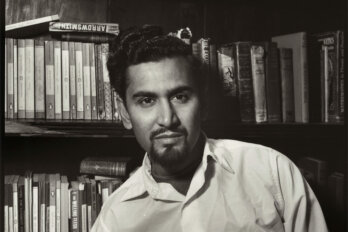BOOKS DISCUSSED IN THIS ESSAY:
Don Quixote
by Miguel de Cervantes
translated by Edith Grossman
introduction by Harold Bloom
HarperCollins (2003)
940 pp., $45
The Enamoured Knight
by Douglas Glover
Oberon Press (2004)
194 pp., $22
Tales Of Don Quixote
by Barbara Nichol
Tundra Books (2004)
216 pp., $23
Life of Pi
by Yann Martel
Vintage Canada (2002)
356 pp., $21
How about this for inspired literary mischief. A writer is late delivering a promised sequel to his best-selling novel. Ten years late, to be exact, a lifetime in the publishing business. In the interim, a rival hiding behind a pseudonym has issued a spurious version that discredits the original. The existence of the counterfeit encourages the writer to hurry quill back to paper. He brings out his Part II, resuming the action a month after Part I ended. His heroes, a knight errant and his faithful squire, are now recognized wherever they go, thanks to that decade-old book, which everyone seems to have read. Knowing they are already the stars of one fiction encourages the pair to embark on further adventures, to provide fresh material for their chronicler. “Does the author promise a second part?” the knight asks a character who has read Part I. He does, the fellow answers.
The same character summarizes the conventional wisdom about sequels. “Second parts were never very good,” he remarks, sounding like a critic of Hollywood blockbusters. So far, this seems a decent play on the fiction of any fiction. But the writer is just warming up. Far from ignoring his rival’s “fake” sequel, he refers to it in his own “real” one as “the false, the fictitious, the apocryphal” version of events. Then he reports rumours that the knight and squire from the imitator’s book are now loose inside his story as well, pretending to be them. This last twist proves too much for his identity-challenged hero. The poor knight demands that a character who has met the impostors swear before a judge that he—and not the other guy—is authentic. “Because there is no other I in the world,” he says.
Sadly for Don Quixote de la Mancha, as the knight is known, this is also a fabrication. His real name is Alonso Quixano, a middle-aged country squire who has suffered a nervous breakdown. In his delirium—the result, unsurprisingly, of an addiction to chivalric romance novels—Alonso has given himself a grand title and quest, involving slaying giants and sacking castles in the service of Dulcinea del Toboso, his lady most fair. She, it so happens, is still another invention, the reality being a buxomy wench called Aldonza Lorenzo whom Alonso is too shy to approach.
“The author of our history must be some wise enchanter,” Don Quixote says of his creator. As usual, he doesn’t know the half of it. Don Quixote doesn’t know that The Ingenious Gentleman Don Quixote de la Mancha is so in the thrall of its own enchantments that it has been wagging its narrative tail for better than 900 pages. He doesn’t know that the author, Miguel de Cervantes, while certainly wise, may be adding to the page count in part because he still isn’t sure how to close the book he has so brilliantly opened.
When the end finally comes for the knight, it is abrupt. He is made to renounce his delusion and then swiftly expire. He is accorded a nice epitaph—“For it was his great good fortune /to live a madman, and die sane”— but is also treated to a proverbial stake-through-the-vampire’s-heart, in the form of a document attesting that the corpse is indeed the real Don Quixote. There will be no sequel to the sequel, by the sage enchanter Cervantes or anyone else.
Miguel de Cervantes published the second part of Don Quixote in 1615, a decade after the first volume had granted the sixty-eight-year-old Spaniard unexpected late-career success, and a year after the appearance of the counterfeit Part II. A failed playwright, he appears to have dashed off both parts of his masterpiece in a hurry, anxious to counter his imitators and return to what he believed was his serious work. In his haste, Cervantes allowed his imagination to wander so far and wide from existing prose genres—the pastoral tale and chivalric romance being the most popular at the time—that he ended up in an entirely new form. Today we call that form the modern novel, and credit him with its invention. The author himself died in 1616, his hopes for immortality pinned to a pastoral adventure titled Persiles y Sigismunda. It is said to deserve its obscurity.
This year marks the 400th anniversary of the first instalment of Don Quixote. The occasion is being celebrated, predictably enough, with a slew of new books, including a fresh translation by the esteemed Edith Grossman and a retelling of the tale for children by Barbara Nichol; The Enamoured Knight, by novelist Douglas Glover, is an appreciation of the novel. Grossman’s translation comes jacketed in an A-list of blurbs, with Carlos Fuentes calling Don Quixote “the most eternal novel ever written” and Thomas Mann’s pronouncement that “its creative genius, critical, free, and human, soars above its age!” Critic Harold Bloom provides an introduction in which he remarks that “this great book contains within itself all the novels that have followed in its sublime wake.”
That might be so. But it might also be the case that four centuries after the birth of the novel—a spectacular birth it was, too, like delivering an eighty-kilogram baby with a wicked sense of humour and a Mensa IQ—the majority of us hardly recognize the form innovated by Cervantes in the fictions we currently admire. The anniversary offers a chance to revisit the enchantments of Don Quixote and also to wonder about the state of enchantment in the literature of our own age.
The book tells the most enduring of stories. The journey of the Knight of the Sorrowful Countenance and his squire Sancho Panza in quest of a new self is the search of all humans for fulfillment and meaning. Quixote’s insanity is triggered by desire, and Dulcinea is a figment of his emotional yearning. The knight, during a moment of lucidity, states that “it is enough for me to think and believe that my good Aldonza Lorenzo is beautiful and virtuous . . . . I depict her in my imagination as I wish her to be.” His search is notable for the questions it asks, not for any answers it provides. How do our minds function? How “real” is reality and “unreal” is illusion? And what of our identities: are they fixed and defined, or fluid and evolving?
Don Quixote is structurally audacious. Cervantes can’t stop messing with the form even while he is still working out the rules for it. He is like the architect who repeatedly complicates his design long after the ground has been broken. By introducing the existence of Part I and the false sequel into Part II, for instance, the author redraws his book, adding further layers of self-awareness and uncertainty. He does so with confidence less in his talent than in the expansiveness of the literary genre coming into existence before his eyes. Between those calfskin covers is so much imaginative and aesthetic space. On those blank pages is such freedom.
On those pages as well is going to be plenty of language, doing what language does: constructing and directing its own metaphors and meanings. Cervantes’ instinctive receptivity to how language functions has endeared him to an intellectual tradition dating backwards from Foucault to Borges to Neitzsche. In The Enamoured Knight, Douglas Glover, a smart and enthusiastic student of the multiplicities of Don Quixote, is keen to talk literary theory. “At this point,” he writes of the intersections at the start of Part II, “Don Quixote severs its last tie with verisimilitude, wrenching itself out of the discourse of reality into the relativity of discourses, of languages, as it were, in that floaty, postmodern, post-structuralist sense of language as a self-referential system of signs.”
Is there anything the novel form designed by Cervantes can’t do? The diligent reader of Don Quixote may end up answering with a flat no. And yet the author is determined to emphasize one restriction, although he probably thinks of it more as an ironic truth. The novel can’t do reality. It can’t ever not be a book. Whether we choose to admit it or not, the moment we open a work of fiction we have exited life and entered art. We’re down a road and off on a quest, and neither the destination, nor necessarily the purposes, are at first obvious.
Miguel de Cervantes was born in 1547 to an old but impoverished family in Alcalá de Henares, near Madrid. He became a soldier in his early twenties, and was wounded in 1571 at the Battle of Lepanto. He was later kidnapped by pirates and sold into slavery in North Africa for five years. Unable to earn a living with his pen upon his return, he worked as a tax collector, a job that had him roaming the Spanish countryside annoying almost everyone he met. He may have begun Don Quixote while languishing in prison for theft or embezzlement. Cervantes never earned a peso from the first part of the book, thanks to an unscrupulous publisher, and throughout his life he remained a marginal figure in Spanish literary circles, the object of derision among more elite wordsmiths.
Don Quixote is an easy psychological match with that biography. Cervantes, either at wit’s end with convention or else in a freefall of innovation (or both), builds his knight out of the muddy clay of his own experiences and disappointments. The result is a depiction of a vividly contemporary psyche. The disillusionment occasioned by repeated failure, the desperation of the poor, even the appeal of madness when reality becomes untenable—the knight and his squire are familiar travellers. That our own era mostly knows Quixote through a sentimental pop-culture digest of the story, in which the knight tilts at windmills and dreams the impossible dream, doesn’t negate the fact that we can relate to a 400-year-old character. We’ll even sing along with the Man of la Mancha, or at least hum the show tunes.
Joining the knight and his guide in their Broadway musical adventure may be the only journey most readers will be able to manage. The novel, it is true, is long and digressive. The writing is also ornate and tirelessly playful. But the more serious problem with Don Quixote is that it fails many of the critical and consumer tests of our literary culture, a culture in the grips of a narrow, bland definition of what constitutes a good book.
The Czech novelist Milan Kundera believes the legacy of Don Quixote has been denigrated by an adherence to the “imperative of verisimilitude” in the novel. He lays partial blame on our fixation with realistic settings and chronological order. Glover qualifies Kundera by suggesting that literary realism is a technique that becomes problematic only “when someone tries to turn it into a definition.” Glover admits, however, that this is precisely what “unthinking writers and journalist-critics” have done. Psychological realism, with its emphasis on credible plots and believable characters, is a major tradition in western literature. But it isn’t the only one.
In 2003, the Observer newspaper published a list of the hundred greatest novels of all time. The books are presented chronologically, starting with Don Quixote and ending with Austerlitz, by W.G. Sebald, published in 2001. Only eight of the titles predate Jane Austen and more than sixty selected books were written in the last century. A scan of the list validates Milan Kundera’s concern about the dominance of the realistic novel. The eighteenth century took Miguel de Cervantes’ adventurous spirit to heart. The era’s essential works, including Robinson Crusoe by Daniel Defoe (published in 1719, and often credited as the first English novel), Jonathan Swift’s Gulliver’s Travels (1726), and Tom Jones by Henry Fielding (1749), share with Don Quixote an unscripted, spontaneous quality that translates into surprises on nearly every page.
With Laurence Sterne’s Tristram Shandy (1759–67), the century had its masterpiece: a hilarious, often unbuttoned work that Kundera praises for its philosophical and aesthetic “lightness.” “What is all this story about?” cries one exasperated Sterne character. The answer is “a cock and a bull,” and it is “one of the best of its kind, I ever heard.”
Once beyond Tristram Shandy, however, the Observer tracks the steady ascendancy of psychological realism. Standing as a counterpoint to nineteenth-century titans like Dickens, Thackeray, Balzac, and Stendhal are the modestly quixotic efforts Alice’s Adventures in Wonderland by Lewis Carroll (1865) and Kenneth Grahame’s 1908 The Wind in the Willows. Twentieth-century modernism shared Miguel de Cervantes’ ardour for innovation, but James Joyce’s Ulysses (1922) and U.S.A. by John Dos Passos (1938) strike many today as chilly, Olympian exercises in expanding the form (and exhausting the reader). Among recent titles, Martin Amis’s Money (1984), with its Cervantes-like cameos by the author, and Wise Children by Angela Carter (1991) possess flair and self-awareness, as does Milan Kundera’s own The Book of Laughter and Forgetting (1980).
Such efforts at literary ranking border on the arbitrary, especially when it comes to contemporary selections. But should the Observer ever update its list, a twenty-first-century novel in the Quixote mode just might make the cut. It unfolds an outlandish yarn about a boy trapped in a lifeboat with a tiger and promises to tell a story that will make readers believe in God. Yann Martel’s Life of Pi, first published in 2001, has been lauded for its originality. The book’s zeitgeist plea for tolerance, especially its blending of three great faiths—Hinduism, Christianity, and Islam—in the character of Pi Patel, has also been a natural focus of attention. Novels rarely succeed in conveying timeless truths and capturing the news of the day.
Less often remarked is that Life of Pi has an old soul. Daniel Defoe would have cheered the boy’s adventures at sea. Jonathan Swift might have nodded approval at the flesh-eating island where Pi nearly meets a grisly end. Laurence Sterne could have offered cock-and-bull advice to Martel about his narrative strategy of demanding we accept the ever-taller tales he presents, by way of literally proving the novel’s contention that humans believe in God because it is, in effect, the better story.
And Cervantes? He’d have appreciated the conflicting explanations for what happened to Pi during those months adrift on the ocean and Martel’s decision to leave the choice up to us. The sense of discovery, of stories and questions being invitations to tell more stories and ask more questions, would likewise have pleased the Spaniard. Then there is the final sentence in the author’s note. “If we, citizens, do not support our artists,” Yann Martel writes, “then we sacrifice our imagination on the altar of crude reality and we end up believing in nothing and having worthless dreams.” Don Quixote himself might have proclaimed such a defiant, foolhardy sentiment.
The extraordinary success of Life of Pi—three million copies sold in some forty countries—may be testament to a latent appeal for narrative enchantment. Novels, it is worth repeating, are always fictions, always invitations to set off on an imaginative quest. That quest is to discover, or perhaps simply be reminded of, what is essential to our natures—i.e. the reality of being human. There is the deeper irony to our voluntary imprisonment in literary verisimilitude. “In our fictional universe,” Douglas Glover concludes, “books teach us to be real.”
“This is how the book begins,” Barbara Nichol tells future adult readers at the start of Tales of Don Quixote. The story is about the hero “Don Quixote—an ordinary man who thinks he is a knight” and the author “writing his big book about his hero.” When Don Quixote was first published, Nichol admits, it was a surprise to people, “not like any books they’d read before. That was 400 years ago. And even now, literature is borrowing ideas from Cervantes and trying to catch up.”






